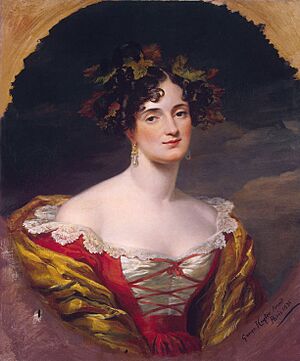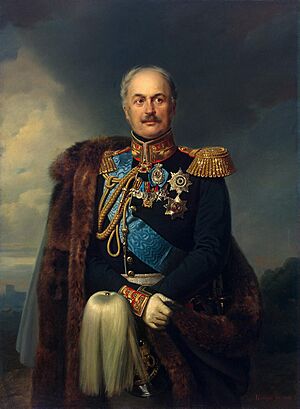Pavel Kiselyov facts for kids
Count Pavel Dmitrievich Kiselyov (born January 19, 1788, in Moscow – died November 26, 1872, in Paris) was a very important Russian reformer. He is known for trying to make many improvements during the time of Emperor Nicholas I. This was a period when Russia was generally quite traditional.
Early Military Life
Pavel Kiselyov first showed his skills during the Napoleonic Wars. He served as an assistant to Count Miloradovich at the Battle of Borodino. He marched with the Russian army all the way to Paris. After this, he became an assistant to Emperor Alexander I.
Five years later, Kiselyov became the Chief of Staff for the Second Army. This army was based in Tulchyn, Podolia. Here, he started to introduce his ideas for change. For example, he tried to reduce and stop corporal punishment, which was physical punishment. This made some powerful people, like the War Minister, Count Arakcheyev, upset. Some members of the Decembrist movement, who wanted big changes in Russia, served under Kiselyov. He supported them, but it's not fully clear how much he encouraged their revolutionary ideas.
Governing the Danubian Principalities
During the Russo-Turkish War, 1828-1829, Kiselyov was put in charge of the Russian troops in Wallachia and Moldavia. These areas are now part of modern Romania. He also became the temporary governor of these regions in October 1829. He was the most powerful person there until 1834. That's when Mahmud II, the leader of the Ottoman Empire, appointed new local rulers. The Danubian Principalities later joined together in 1859 to form Romania. They became fully independent from the Ottoman Empire in 1878.
Under Kiselyov's leadership, these two states received their first constitutions. These were called the Regulamentul Organic (or "Organic Statute"). This set of rules was introduced in Wallachia in 1831 and in Moldavia in 1832. It stayed in use until the two regions united in 1859. Even with some problems, this Statute helped the economy and politics of the areas. Kiselyov also helped create an important road in Bucharest, the capital of Wallachia. It is called Șoseaua Kiseleff (Kiseleff Road) and is still used today.
Plans for Change
In 1835, Kiselyov returned to Saint Petersburg. He joined the State Council of Imperial Russia, which was a group that advised the Emperor. He also joined secret groups discussing how to free the serfs. Serfs were peasants who were tied to the land and belonged to landowners. In the same year, Kiselyov gave the Emperor a detailed plan for reforms. This plan worried many conservative landowners, so the Emperor did not use it. It is thought that Kiselyov had first thought of this plan back in 1816.
Two years later, Kiselyov became the Imperial Minister of State Properties. This was a very important job, and he did it well for 18 years. In 1839, Kiselyov was given the title of count. He then reformed how state-owned peasants were managed. He also started a system of schools for peasant children. These schools were commonly known as the Kiselyov Schools.

Kiselyov could not continue with all his reform plans. This was because traditional forces gained more power until Emperor Nicholas I died in 1855. Nicholas's son, Emperor Alexander II, sent Kiselyov to Paris. His job was to deal with the results of the Crimean War.
Kiselyov was married to Countess Sofia, but their only son died when he was a baby. Because of this, Kiselyov spent a lot of time with his nephews from the Milyutin family. He hoped his nephew, Nikolay Milyutin, would lead the serf emancipation reform that happened later. His other nephew, Dmitry Milyutin, was responsible for big changes in the Russian military in the 1870s. Kiselyov stayed in diplomatic service until 1862. At that time, his health was failing, and he had to leave his positions. He never went back to Russia and passed away in Paris ten years later.
See also
- Kiseleff Cup



